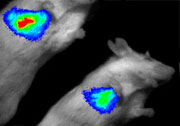Research
Highlights...
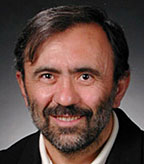
|
Ames Lab's
Costas Soukoulis
|
|
 |
Number 208 |
May 1, 2006 |
|
Cell surface profiling could yield cancer blood test
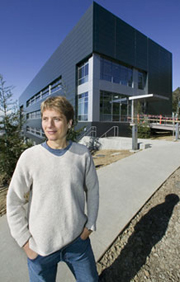 |
|
Carolyn Bertozzi is the director of Berkeley Lab's Molecular Foundry. |
A chemical profiling technique that has potential for detecting the onset of cancer at the cellular level has been developed by scientists with DOE's Lawrence Berkeley National Laboratory. Led by chemist Carolyn Bertozzi, the Berkeley Lab scientists have reported a technique for rapidly profiling O-linked glycoproteins in living animals. Changes in O-linked protein glycosylation, the attachment of sugars to proteins through an oxygen atom on the protein, are known to correlate with cancers and other diseases, such as inflammations and infections. Until now, however, scientists have lacked a practical means of monitoring such changes in a physiological setting.
[Lynn Yarris 510/486-5375,
lcyarris@lbl.gov]
|
|
CDF achieves precision measurement of a subtle matter-antimatter dance
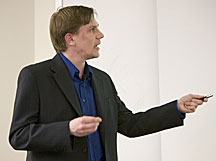 |
| Ivan Furic of the University of Chicago revealed CDF's latest B_s results to a packed crowd at Fermilab on April 10. |
Scientists of the CDF collaboration at DOE's Fermi National Accelerator Laboratory www.fnal.gov have announced the precision measurement of extremely rapid transitions between matter and antimatter. It has been known for 50 years that very special species of subatomic particles can make spontaneous transitions between matter and antimatter. In this exciting new result, CDF physicists measured the rate of the matter-antimatter transitions for the Bs (pronounced "B sub s") meson, which consists of the heavy bottom quark bound by the strong nuclear interaction to a strange anti-quark. The staggering rate challenges the imagination: three trillion times per second.
[Siri Steiner, 630/840-3351,
siri@fnal.gov]
|
|
INL researchers provide cyber security training to utility owners
At the recent Process Control and Supervisory Control and Data Acquisition (SCADA) Summit, sponsored by the SANS Research Institute, researchers and scientists from DOE's Idaho National Laboratory provided two-days of comprehensive cyber security and control systems training to more than 300 private utility engineers and equipment manufactures from the United States and 23 foreign countries. The training ranged from introductory security courses, to more advanced hands-on training in SCADA and control systems security. On the last day of the Summit , California Congressman Dan Lungren, a member of the House Homeland Security Committee, awarded several companies and agencies including INL, the Department of Energy and the Department of Homeland Security with SCADA Leadership Awards.
[Ethan Huffman, 208/526-0660,
ethan.huffman@inl.gov]
|
Scientists study dynamics that create and sustain fluid vortices
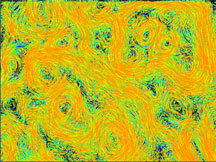 |
| The computer-generated circulation patterns created in the experiments are reminiscent of Vincent Van Gogh's impressionist masterpiece "Starry Night." |
Scientists at DOE's Los Alamos National Laboratory in New Mexico and Johns Hopkins University in Baltimore have developed a new theory that for the first time quantitatively describes the physical process of how small-scale swirling patterns in fluids, or vortices, can become large-scale, long-lasting circulation patterns, like Jupiter's red spot. Through both computer modeling and laboratory experiments on thin salt-water layers, the scientists were able to observe the physical processes and measure the energy transfer of two-dimensional inverse energy cascades in turbulent fluids. Their findings confirmed theories that the energy transfer by stretching of small-scale vortices sustains the large-scale vortices.
[Kevin Roark, 505/665-9202,
knroark@lanl.gov]
|
Spallation Neutron Source makes first neutrons
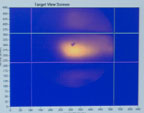 |
| This detector glowed as a stream of protons struck the Spallation Neutron Source target |
One of the largest and most anticipated U.S. science construction projects of the past several decades has passed its most significant performance test. DOE's Spallation Neutron Source, located at Oak Ridge National Laboratory, has generated its first neutrons. Just after 2 p.m., Friday, April 28, a pulse of protons from the SNS's accelerator complex, traveling at nearly the speed of light, struck its mercury target. The protons "spalled" neutrons from the nuclei of mercury circulating inside the target. "We are now officially a neutron source," said SNS Director Thom Mason.
[Bill Cabage, 865/574-4399,
cabagewh@ornl.gov]
|
Argonne and Fermilab sign agreement, anticipate state funding
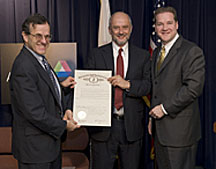 |
| Illinois Department of Commerce and Economic Opportunity Director Jack Lavin (right) presents Argonne Director Robert Rosner (left) and Fermilab Director Pier Oddone with the Particle Accelerator Day proclamation. |
To increase the cooperation on numerous R&D projects, including the proposed International Linear Collider, the Department of Energy's Fermi National Accelerator Laboratory and Argonne National Laboratory signed a Memorandum of Understanding on Friday, April 21. Highlighting the support of the State of Illinois for basic scientific research, the signing ceremony took place at the James R. Thompson Center , site of the Governor's Chicago office. Governor Rod Blagojevich issued a proclamation declaring "Particle Accelerator Day" in Illinois. The Governor's proposed budget for the FY'07 includes $3 million to begin construction of an Illinois Accelerator Research Center at Fermilab, which would strengthen the ability of Fermilab and Argonne to compete successfully for accelerator projects such as the ILC.
[Kurt Riesselmann, 630/840-3351,
kurtr@fnal.gov]
|
|
|
From Dance to Descartes
Costas Soukoulis enjoys kicking up his heels, especially in traditional Greek dance. By his own admission, he's a good dancer. A close colleague testifies to his skill, declaring, "He's the god of Greek dance!"
So what does all this dancing have to do with the life Soukoulis leads as an Ames Laboratory senior physicist and an Iowa State University distinguished professor of physics? Plenty if you realize the important role dance plays in the lives of Greek people.
It’s an expression of human feelings and everyday life. It influences the soul, according to Plato, the ancient Greek philosopher. And for Soukoulis, who grew up with the dance, that influence led to and continues to thrive in his passion for physics, in particular the field of left-handed materials, LHMs, a new subclass of materials he created in collaboration with a top-notch team of international researchers.
These artificial materials, also known as metamaterials, exhibit negative refraction, bending light in the opposite direction to that seen in natural materials. They can be fabricated to have zero reflectance and can focus light without the need for curved surfaces, promising a wide range of potential applications for LHMs, especially within the fields of medical diagnostics and cellular communications.
The superb work of Soukoulis and his colleagues in demonstrating the experimental reality of LHMs and their consistency with the laws of physics was recognized when the research team was awarded the 2005 Descartes Prize for Excellence in Scientific Collaborative Research, the European Union's highest honor in the field of science.
"I feel lucky to be one of the first people working in this completely new field of LHMs—it's a great opportunity to combine basic and applied physics and rewrite some of the laws of electromagnetism," says Soukoulis, who also studies photonic crystals, random media and wave propagation and, of course, continues to dance!
Submitted by DOE's
Ames Lab
|
|







